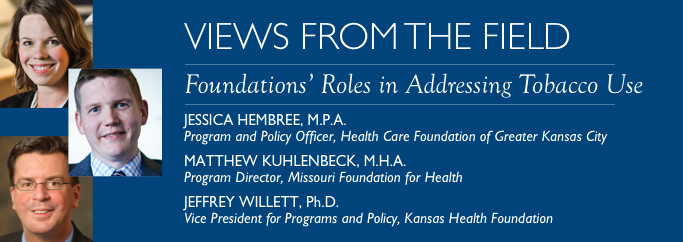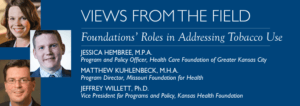
Amidst the backdrop of substantial decreases in tobacco use among adults, and particularly young people, tobacco prevention can seem to be a battle that has been fought and won. There is still much to do, however, to protect individuals from secondhand smoke, prevent youth from beginning tobacco use, and address tobacco related disparities. Tobacco remains the leading preventable cause of death in the United States and the world and is a major factor in four of the five leading causes of death.
Philanthropy can play a unique role in addressing tobacco use. Government and private industry do not have the unencumbered resources and long-term lens to address this intractable health problem. As foundations who have supported tobacco control efforts over the past 10 years, we can say unequivocally there are solutions and foundations can play a leading role in creating “needle moving change” on tobacco use when resources are directed effectively. Local capacity building, policy advocacy, and system changes have proven to be the most effective tools to decrease tobacco use at local, state, and national levels.
New Energy in Kansas City
The Health Care Foundation of Greater Kansas City made its first grant in 2005 in support of a local tobacco free coalition that pursued clean air ordinances throughout the metro area. Within years, more than 95 percent of metro area residents lived in cities with smoke-free air ordinances. Following this success, community-based tobacco coalitions faced an identity crisis. Their success in policy change had effectively “put themselves out of business” and they struggled to coalesce around new policy priorities. It was not until the recent push for Tobacco21 policies that prevention advocates regained their momentum.
Of current smokers, more than 95 percent began smoking before the age of 21, making policies to increase the age of sale for tobacco and nicotine products a critical opportunity to prevent nicotine addiction. In October 2015, the Greater Kansas City Chamber of Commerce launched Tobacco21|KC, a call to action to raise the age of sale for tobacco products to 21 throughout the Kansas City region. HealthyKC is a partnership of the Greater KC Chamber, Blue Cross and Blue Shield of Kansas City, and the Health Care Foundation of Greater Kansas City with business, health care organizations, hospitals, nonprofits, government, and more to improve the health of Kansas City. Many public officials have noted that the collaboration between the health and business sectors was a key factor in their decision to support Tobacco21 policies within their cities.
Since the launch of Tobacco21|KC, localities from throughout the region have enthusiastically embraced Tobacco21 as a strategy to reduce youth smoking. As of July 2016, 15 cities in the Kansas City region have adopted Tobacco21 policies and eight others will consider it in the coming months. To date, more than 75 percent of residents in the HCF service area live in communities with Tobacco21 policies. If every city in the HCF service area adopts a Tobacco21 policy, it is estimated that over the next 10 years, the policy will prevent 12,330 young people from becoming addicted smokers; save 4,110 lives; and generate $72 million in savings to private employers. The Tobacco21 effort has placed a renewed focus on tobacco, which remains a substantial driver for poor health outcomes in the region.
Changing the Culture around Tobacco
The Kansas Health Foundation (KHF), a statewide conversion foundation based in Wichita, has also been a long supporter of tobacco prevention. While Kansas has recently seen a drop in overall rates of smoking, several tobacco-related disparities have increased. A 2014 study funded by KHF found the smoking rate among Kansas adults with a serious mental health disorder was 45.7 percent compared to 17.3 percent for other adults. The high rate of smoking contributes to why, on average, mental health consumers die 25 years earlier than the general population.
KHF believes progress on this important health issue is necessary to see further reductions in smoking. With support from KHF, a leadership team of 22 stakeholders developed a strategic plan to reduce tobacco use among Kansans with poor mental health. It included consumers of mental health services, behavioral health providers, state agency staff and public health professionals.
A key strategy identified by the team was to change the culture of the behavioral health system so tobacco was treated as a serious health issue. Foundation staff worked with the leadership team to develop a request for proposals to fund several grants focused on culture change. A grant to Kansas National Alliance on Mental Illness will support advocacy efforts to expand state Medicaid benefits for smoking cessation. Grants to behavioral health providers will help integrate tobacco dependence treatment into behavioral health systems. Grants to the University of Kansas and Wichita State University will support training for tobacco treatment specialists and an evaluation of the initiative.
Through these grants, convenings and ongoing engagement of the leadership team, KHF hopes to see progress on an aspect of tobacco use not typically addressed by state health agencies.
Return on a Long-term Investment
In 2004, Missouri Foundation for Health’s (MFH) Board of Directors committed $40 million over nine years to establish the Tobacco Prevention and Cessation Initiative (TPCI). The overarching goal of TPCI was to support efforts to reduce the negative health effects and economic burden of tobacco use in Missouri. MFH funded 123 grants with the first grant beginning in December 2004 and the last grant concluding in June 2014.
The TPCI funding structure evolved over the course of the Initiative leveraging the unique role MFH could play in advancing tobacco control in Missouri. In nine years, TPCI first developed community capacity through local programming grants and targeted technical assistance and then used it to develop and advance regional and statewide policy advocacy efforts.
As a result of this long-term commitment, Missouri made marked progress in addressing tobacco use and secondhand smoke exposure. Its smoking prevalence decreased significantly and at a faster rate than the overall national decline. In 2010, Missouri had 124,121 fewer adult cigarette smokers, compared to when TPCI funding began in 2004. The total combined benefit of TPCI during the time period resulted in real savings: 16,983 quality of life years gained and lifetime medical care savings of $108 million. The initiative also realized a positive return on investment (ROI), returning $4.68 in long-term medical savings for every $1 invested. The greatest gains were made in policy change, which had an ROI of $17.13 per $1.00 invested.
Although many tobacco control partners contributed to these successes, TPCI’s influential role and positive impact on Missouri’s tobacco control environment is undeniable. Major conclusions from the external evaluation of TPCI include:
- MFH provided important leadership, infrastructure, and capacity building for tobacco control professionals in Missouri through TPCI.
- Communitywide policy changes advocated by TPCI grantees had an impact on smoking rates and corresponding health care costs.
- TPCI has been one of the most important public health initiatives during the last decade in Missouri.
Next Steps
Foundations can play an important role in improving overall health through a focus on tobacco control. While significant strides have been made, future investment by the state and other tobacco control partners is more important than ever. New trends in tobacco use, particularly electronic cigarettes and vaping devices, threaten to undo decades of tobacco prevention by offering youth and adults a seemingly low-risk mechanism to access nicotine. In addition, local and state policy change has stagnated across the United States. Foundations that are new to this issue can begin by convening key stakeholders, raising awareness of the impact tobacco has community health, and advancing local and state policy change – all of which are strategies that have been proven effective.

